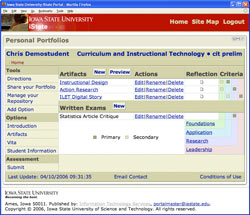Inside Iowa State
Inside ArchivesSubmit newsSend news for Inside to inside@iastate.edu, or call (515) 294-7065. See publication dates, deadlines. About InsideInside Iowa State, a newspaper for faculty and staff, is published by the Office of University Relations. |
April 28, 2006 A new way to 'wow' them: electronic portfoliosby Samantha Beres Student portfolios or collections of work often come in the form of a three-ring binder filled to the brim with reflection and analysis. That binder or box might hold a large project, a semester's worth of work or the requirements for an entire program of study. Now, a new tool called eDoc allows Iowa State students to create portfolios electronically. 
It gives students creative freedom -- and a way to save a little money on paper. And instructors and advisers are finding that electronic portfolios are an effective, alternative way to assess student learning. How students use itFreshman food science major Kaitlyn Wiener has been developing her e-portfolio all year. It includes her resume, choice assignments and written reflections on each piece of work. These reflections, she said, allow her to see her accomplishments and how her goals change over time. "Another benefit is the ability to access my portfolio from anywhere," Wiener said. This came in handy when she wanted to add something to her portfolio from her home computer, rather than the one she uses at school. Many students (including Wiener) plan to burn their portfolios on CDs and hand them to prospective employers. De Zhang is working on a doctorate in education and opted to do an e-portfolio instead of a written preliminary exam, the final step before dissertation. "As I was preparing it, I realized how much I've learned and how much I've changed," Zhang said, adding that this would not have been demonstrated through a written exam. "It allows student-centered learning and reflection. I took control of what I wanted there," she said. She chose her best work, including a paper accepted for publication. Zhang also used a video in her electronic portfolio to give a tour of a Chinese WebCT-supported online learning environment she developed for students learning Chinese. The video shows materials for the class written in Chinese, but it is narrated in English making it accessible to her professors, some of whom do not understand Chinese. Users can easily upload all sorts of files, including JPEG photo images, PowerPoint presentations, and audio and video clips. Developing an eDoc themeOne might ask, "Why not just create a Web site?" "What I really like about eDoc is that students don't have to know Web design. They can focus more on content and we can spend more time on student learning within the discipline," said academic adviser Anne Oldham. She teaches an orientation course and has been involved in developing the eDoc portfolio theme for the food science and human nutrition department. Each department, class or program can easily develop its own eDoc theme, depending on the needs of its students. The design structures the competencies, information and documents within the portfolio. For example, there is a list of the competencies specified by the American Dietetic Association for dietetic interns within their portfolio, and the interns indicate when each competency has been met. That eDoc format helps the user verify that all learning outcomes are met. Changing student assessmentE-portfolios can be developed for a single class, a series of classes or a degree program. But a grade on the end result is not the only option. The eDoc users can grant access to guests, peers and evaluators; then, instructors can easily log in to see how a student is progressing. "On the surface, it appears that we've taken a hardcopy portfolio and put it in an electronic version," said co-director of the eDoc project Tom Alsbury, educational leadership and policy studies. "But what we've learned is much deeper than that. Instructors can engage in a much more ongoing, formative process." Alsbury cites an example: Traditionally, a graduate student would show up at his or her defense and committee members would have read the thesis just prior. With eDoc, committee members can log in, look at and comment on a student's thesis (portfolio) from the beginning. Oldham points out that the e-portfolios are in line with a shift in learning, one in which students can do self-assessment as they go along. "Expectations and goals are within the portfolio and students can show how they're meeting those goals or recognize where they're not as strong," she said. "We want students and interns to take more ownership of their learning." So far, approximately 800 students are using eDoc and there are 16 themes developed by various departments. In addition to the program-specific themes, there is a generic version that allows users to create their own categories and portfolio organization. For more information about e-portfolios, or to develop an eDoc theme for your department, contact Rex Heer, electronic portfolio program coordinator for CELT, at eportfolio@iastate.edu, 4-6072. |
Quote"On the surface, it appears that we've taken a hardcopy portfolio and put it in an electronic version. But what we've learned is much deeper than that. Instructors can engage in a much more ongoing, formative process." Tom Alsbury, educational leadership and policy studies |